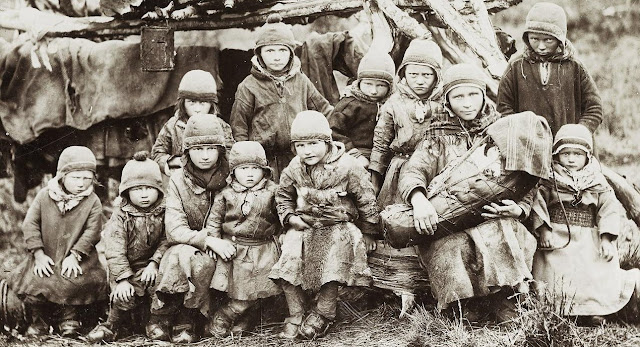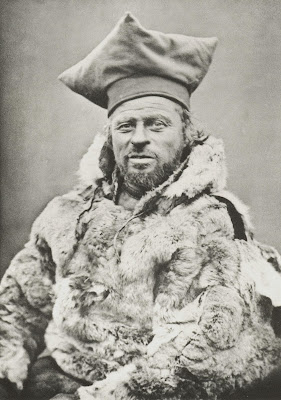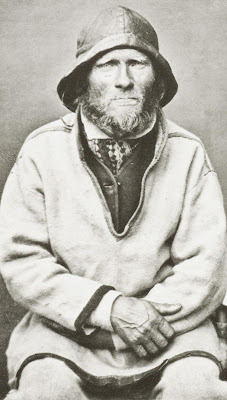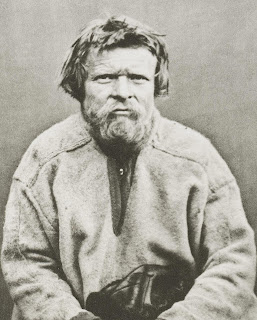 Sami family. Samisk familie. Publ:1822
Sami family. Samisk familie. Publ:1822The Prince sent in 1496 Gregory Istoma to the Court of King John of Denmark in order to acquire Latin Language. The Journey: Novgorod (Russia) - The White Sea - Finlapeia - Ditciloppi (the land of the wild Laplanders) - Trondheim - Bergen - Denmark. It is interesting to read that there were herds of reindeer in Trondheim at that time. Bergen was described as North in Norway.
Prinsen sendte i 1496 Gregory Istoma til Danmark for å lære latin ved hoffet til Kong John av Danmark. Reisen: Novgorod (Russland) - Hvitsjøen / Kvitsjøen - Finlapeia - Ditciloppi (landet til de ville samene) - Trondheim - Bergen - Danmark. Det er interessant å lese at det var reinsdyrflokker i Trondheim på den tiden. Bergen ble beskrevet som nord i Norge.
 King John of Denmark (about 1455 to 1513).
King John of Denmark (about 1455 to 1513). He told about his journey to Baron Sigismund von Herberstein: They had traveled through Novgorod in Russia to the mouths of Dvina and Potivlo where they party embarked in four boats and sailed along the right hand shore of the ocean.
Han fortalte om sin reise til Baron Sigismund von Heberstein: De hadde reist gjennom Novgorod i Russland til munningen av Dvina og Potivlo hvor selskapet gikk om bord i fire båter og seilte langs kysten på høyre hånd.
 Sami men skiing. Samiske menn på ski. Publ. Olaus Magnus, 1555
Sami men skiing. Samiske menn på ski. Publ. Olaus Magnus, 1555“and after accomplishing sixteen miles and crossing a certain gulf, they sailed along the left shore. Leaving the open sea to their right, they came to the people of Finlapeia. Although these people dwell in low cottages, scattered here and there along the seacoast, and lead an almost savage life, Istoma reported, yet they are more gentle in their manners than the wild Laplanders. (end of quote)
Etter å ha seilt seksten mil og krysset en viss bukt, seilte de videre langs kysten på venstre hand. Når de seilte fra det åpne hav på sin høyre side, kom de til Finlapeia folket. Selv om disse folkene bodde i lave hytter som var spredt her og der langs kysten, og nesten levde et usivilisert liv, rapporterte Istoma at de likevel er vennligere i sin væremåte enn de ville Laplanders.
 The wildness of the Dwellers. Villskapen til beboerne. Olaus Magnus, 1555.
The wildness of the Dwellers. Villskapen til beboerne. Olaus Magnus, 1555. “He stated that they were tributary to the Prince of Muscovy. A voyage of eighty miles, after leaving the land of the Laplanders, brought them to the country of Nortpoden, which was subject to the King of Sweden. The Russians call the country Kaienska Semla; and the people, Kaiemai. After having passed two perilous promontories, they sailed up to the country of the Ditciloppi, who are wild Laplanders, to a place named Dront [Drontheim], two hundred miles north of the Dvina.” (end of quote)
Han hevdet at de var sendt av Prinsen i Moskva. En reise på åtti mil, etter å ha forlatt landet til Laplanderne, brakte dem til landet Nortpoden, som var et område under svenskekongen. Russerne kaller dette området Kaienska Semla, og folket for Kaiemail. Etter å ha passert to halvøyer, seilte de opp landet til Ditciloppi, som er de ville Lappene, til et sted kalt Dront [Drontheim], to hundre mil nord for Dvina.
 Wild Lapp from Norway about mid 1700eds, published 1780 - 1800. En vill-lapp fra Norge fra en gang midt på 1700-tallet.
Wild Lapp from Norway about mid 1700eds, published 1780 - 1800. En vill-lapp fra Norge fra en gang midt på 1700-tallet. I have so far not found many reports about “the wild Laplanders of Ditciloppi”, however they might be the Saami along the Norwegian coast to Trøndelag. In a map made by
Hieronymus Münzers from 1493 it seems correct that the Wild Laplanders (Wildlappen) indeed were the ones settled along the Northern part of the Norwegian coastal line. See a closer description down this blog about location of Ditciloppi from Istoma's Journey. It seems correct that the Wild Laplanders settled the coastal line south of Lofoten to Trondheim.
Recently I have found out more: In the period between 1400-1700eds different authors have described the geographical localization of the Wild-Lapps between the Kola Peninsula in the north east and all along the coastal line of present Norway to Trondheim, and additionally the Wild Lapps were found in the woods and on the mountains. J.L. Wolf (1716) (my translation): in this county/ in the fjords/ there live Finns/ that also is called Wild Lapps/ Fjeld-Finner (mountain finns)/ or Lapfinner” (Norrigia Illustrata). Another source that supports the view that the Wild-Sami also lived in the areas of the Kola Peninsula is
Samenes historie frem til 1750 av Lars Ivar Hansen og Bjørnar Olsen, 2004, side 21. These books are unfortunately only available in Norwegian language.
 A segment of Hieronymus Münzers 1493 map over Northern Europe. In this Medieval Map there is an area called Wildlappen, north of Mitnacht and Norwega. In the descriptions of Gregory Istoma, the areas of the Wild Lapps went further south to Trondheim or near Trondheim. Dette er et segment av kart over Nord-Europa av Hieronymus Münzers (1493). I dette kartet fra middelalderen kan man se et område som kalles vill-lapper eller Wildlappen, nord for hva som kalles Mitnacht og Norwega. I beskrivelsene til Gregory Istoma så gikk områdene til vill-lappene lengre sør, helt til eller i nærheten av Trondheim.
A segment of Hieronymus Münzers 1493 map over Northern Europe. In this Medieval Map there is an area called Wildlappen, north of Mitnacht and Norwega. In the descriptions of Gregory Istoma, the areas of the Wild Lapps went further south to Trondheim or near Trondheim. Dette er et segment av kart over Nord-Europa av Hieronymus Münzers (1493). I dette kartet fra middelalderen kan man se et område som kalles vill-lapper eller Wildlappen, nord for hva som kalles Mitnacht og Norwega. I beskrivelsene til Gregory Istoma så gikk områdene til vill-lappene lengre sør, helt til eller i nærheten av Trondheim.
Så langt har jeg ikke funnet mye informasjon om ”de ville Laplanderne av Ditciloppi”, men de er antakeligvis samene langs norskekysten til Trøndelag. På et kart laget av
Hieronymus Münzers fra 1493 ser det ut til å stemme at de ville Laplanderne (Wildlappen) er de som bodde langs den nordlige norskekysten. Se på en nærmere beskrivelse av Istomas reise lengre ned in denne bloggen, der finner man ut noe mer lokalitet. Det ser ut til å være riktig at vill-lappene holdt til mellom Lofoten og Trondheim.
Senere har jeg funnet ut mer: Ulike forfattere har fra 1400-1700 tallet beskrevet at "de ville Samene" (Vill-Lappene) bor fra Kola halvøya i nordøst og langs hele norskekysten til Trondheim, og Vill-Lappene fant man også inne i skogene og på fjellene. J.L. Wolf (1716): ”Udi dette Læn/inde ved Fjordene/der boe Finner/som ellers kaldis Vildlapper/ Fjeld-Finner/ eller Lapfinner/” (Norrigia Illustrata). Source: Samene og andre urbefolkninger i nordområdene, av H. Lindkjølen, 1994. En annen bok som viser til kilder som støtter synet om at villsamene også bodde områdene på Kola halvøya:
Samenes historie frem til 1750 av Lars Ivar Hansen og Bjørnar Olsen, 2004, side 21.
 Samisk skiløper. Sami skiier. Published 1822.
Samisk skiløper. Sami skiier. Published 1822.They then came to Drontheim (Trondheim):
“They then left their boats and performed the rest of their journey by land, in sledges. He further related that there are herds of deer there, as plentiful as oxen are with us, which are called in the Norwegian language 'rhen.' They are somewhat larger than our stags, and are used by the Laplanders instead of oxen, and in the following manner: they yoke the deer to a carriage made in the form of a fishing-boat, in which the man is bound by his feet lest he should fall out while the deer is at full speed; in his left hand he holds a bridle, to guide the course of the deer, and in his right a staff, with which to prevent the upsetting of the carriage, if it should happen to lean too much on either side. He stated that, by this mode of travelling, he himself had accomplished twenty miles in one day, and had then let loose the deer; which returned of its own accord to its own master and its accustomed home." (end of quote)
De kom så til Drontheim (Trondheim):
De forlot da båtene og foretok resten av reisen på land, i sleder. Han fortalte sammenliknende at det var flokker med dyr der, like mange som det er okser hos oss, som på norsk kalles ”rhen”. De er noe større enn våre kronhjorter, og blir av laplanderne brukt i stedet for okser, på følgende måte: De binder dyret til en slags vogn som er formet som en fiskebåt, hvor man er bundet ved føttene for ikke å falle ut mens dyret er i full hastighet, i sin venstre hånd holder han en tømme, for å styre retningen på dyret, og i sin venstre hånd en stav, som brukes for å hindre at vognen velter hvis den skråner (vender) for mye til den ene eller andre siden. Han hevder at på denne reisemåten så reiste han selv tjue mil på en dag, og så satte han fri dyret, som av seg selv fant veien hjem og returnerte til sin eier.
 Samisk mann med rein og pulk, publisert 1822. Sami man with reindeer and sledge.
Samisk mann med rein og pulk, publisert 1822. Sami man with reindeer and sledge.They then reached Bergen North in Norway (clearly our maps have changed since then). De nådde da Bergen Nord ganske langt nord i Norge (det er helt klart at våre kart er endret siden den gang).
The text of Gregory Istoma mentioned the Lapps and the reindeer as far south as Bergen in this travel description. Bergen was also mentioned in a text from late 1800s: "The low limit of the fjeld Finns is the sea-level, about the North Cape. In Sweden the deer only come down in winter. There is plenty of moss pasture near the sea, but a certain fly drives deer and men to the snow. Further south, wild reindeer keep on the high tops, about Romsdal. Tame deer are kept as far south as Bergen, but they do not flourish in that wet climate, and they are kept on the high fjeld. They never come down to the sea or to rich grass pasture, but seem to prefer cold, and moss which grows in cold regions.” J. F. Campbell, 1866.
Teksten til Gregory Istoma nevner Lappene og reinsdyr så langt sør som Bergen i denne reisebeskrivelsen. Bergen er også nevnt i en tekst fra sist på 1800-tallet:
(her oversatt) “Det laveste høyden for fjell Finner er sjø-nivået, omtrent Nordkapp. I Sverige kommer dyra kun ned om vinteren. Det er mye mose nært sjøen, men visse insekter driver dyr og menn til snøen. Lengre sør, finnes det reinsdyr på de høye toppene, som Romsdal. Tamme dyr holdes så langt sør som Bergen, men de er ikke mange i et slikt vått klima, og de holdes på høyfjellet. De kommer aldri ned til sjøen eller til rike gressland, men fortrekker kulde, og mose som gror i de kjølige regioner. J.F. Campbell, 1866.
Map by / Kart av Olaus Magnus, 1520
In this map you can see that Norvegia is at the southern tip of present Norway, south of Tilemarchia. På dette kartet kan du se at området som ble kalt Norvegia var på sørspissen av dagens Norge, sør for Tilemarchia (Telemark). “Having at length accomplished this journey, they came to Berges [Bergen], a city of Norway, quite in the north, amongst the mountains, and then reached Denmark on horseback.” (end of quote)
“Etter å ha gjennomført denne reisen kom de til Berges [Bergen], en by i Norge, helt i nord, mellom fjellene, og så nådde de Danmark på hesteryggen.”
The text is quoted from the following book. Teksten er sitert fra følgende bok:
Memoirs of the American Anthropological Association Volume IV (1917)
Sami man in sledge, engraving published in 1822. Samisk mann i pulk.
Closer description of the Journey of Istoma in Nordland and Trondelag - En nærmere beskrivelse av reisen til Istoma i Nordland og Trøndelag. A more detailed description from the travel between a Malstrom in Nordland and Trondheim gives a better idea where the “wild Laplanders of Ditciloppi” are located geographically. En mer detaljert beskrivelse av reisen mellom en Malstrøm i Nordland og Trondheim gir en bedre forståelse av hvor de "ville Lappene av Ditciloppi" befant seg geografisk sett.
 Malstöm in Norway, Olaus Magnus Carta Marina.
Malstöm in Norway, Olaus Magnus Carta Marina.“After sailing thence along a very indented coast which jutted out to the right, they came to a peninsula, called the Holy Nose, consisting of a great rock, which like a nose projects into the sea. But in this there is a grotto or hollow which for six hours at a time swallows up water, and then with great noise and din casts out again in whirls the water which it had swallowed. Some call it the navel of the sea, others Charybdis. It is said that this whirlpool has such power, that it draws to itself ships and other things in its neighbourhood and swallows them.
Istoma said that he had never been in such danger as at that place, because the whirlpool drew the ship in which he travelled with such force, that it was only by extreme exertion at the oars that they could escape. After passing this Holy Nose they came to a rocky promontory, which they had to sail round.“ (End of quote)
Etter å ha seilt langs en ujevn kystlinje som stikker frem mot høyre, så kom de til en halvøy som kalles ”Hellig Nese”, som består av et stort fjell, som er lik en nese og som går rett ned i sjøen. Men i den er det en grotte eller hule som svelger vann i seks timer og så kaster ut igjen med virvler det vannet det hadde svelget med en høy lyd og bulder. Noen kaller dette navlen til havet, andre for Charybdis. Det er sagt at denne virvel-strømmen har en slik kraft at den drar til seg skip og andre ting som kommer i nærheten og svelger dem. Istoma fortalte at han aldri hadde vært i så stor fare som på den plassen, fordi virvelen dro til seg skipet de reiste med en sånn styrke, at det kun var ekstrem hard roing med årer som gjorde at de klarte å unnslippe. Etter å ha passert den Hellige Nesen kom de til en klippehalvøy som de måtte seile rundt. Source Gutenberg:
The Voyage of the Vega, Vol. I” by A.E. Nordenskiöld, 1881
 Malstrøm i Norge sluker skip. Malstrom in Norway swallows a ship. Picture published 1813 This was likely / Sannsynligvis var dette: Saltstrømmen / Moskstraumen
Malstrøm i Norge sluker skip. Malstrom in Norway swallows a ship. Picture published 1813 This was likely / Sannsynligvis var dette: Saltstrømmen / MoskstraumenTo shorten the text: They passed a rock called
Semes that was considered dangerous to pass, if not the captain had offered for a favourable wind. They then sailed further until they came to another great promontory called
Motka, resembling a peninsula. At the end of this there was a castle, Barthus, which means vakthus, watch-house, for there the King of Norway keeps a guard to protect his frontiers. This promontory was so long that it could scarcely be sailed round in eight days and they carried their boats and baggage over land for the distance of about half a mile. They then sailed on along the land of the Dikilopps or the Wild Lapps to a place which is called
Dront (Trondhjem).
For å korte ned teksten: De passerte et fjell eller en klippe kalt
Semes som ser ut til å ha vært oppfattet som farlig å passere, hvis ikke kapteinen hadde ofret for å få en mer fordelaktig vind. De seilte videre inntil de kom til et fremspring kalt
Motka, som så ut som en halvøy. På enden av denne var det et slott, Barthus, som betyr vakthus, hvor kongen i Norge har vakter for å beskytte grensene. Denne halvøyen var så lang at det ville ta åtte dager å seile rundt og de bar derfor bagasje og båter over land i en halv mil. Så seilte de langs landet til Dikilopps eller de ville lappene til en plass som kalles
Dront (Trondhejm).
My comment: The last part describes a peninsula called Motka between Nordland and Trondheim. I cannot tell what place this is. The only place I know with the name Motka is related to the Kola Peninsula and the Sami there, but the place Motka in this text have to be located south of Lofoten but north of Trondheim on the coast of Norway. Min kommentar: Den siste delen nevner et sted kalt Motka, jeg vet at det finnes en slik benevnelse ”Motka” knyttet til Kolahalvøya og samene der, men den plassen som i denne teksten blir kalt Motka må være lokalisert sør for Lofoten og nord for Trondheim på kysten av Norge.
CONCLUSION / KONKLUSJON:From this text one can conclude that the Wild Laplanders or Lapps settled the coast from south of Lofoten towards or to Trondheim, however according to several old texts the Wild-Lapps were also at the Kola Peninsula and along the coast of Finnmark as well as in the forests and on the mountains. Fra denne teksten kan man med sikkerhet konkludere er at vill-samene bodde sør for Lofoten i retning av og eventuelt helt til Trondheim, men flere gamle tekster beskriver også vill-samer på Kola halvøya og på Finnmarkskysten, samt i skogene og på fjellene.
Ptolemy 2nd Century CE: Lappelanth in Southern Sweden? 2. århundret etter Kristus: Lappelanth i Sør-Sverige?In my search for Ditciloppi, I found an area called Pilappelanth and still a another Lappelanth in Southern Sweden. This placename is clearly Lappeland, however the prefix “pi” have made some, for instance
Bruno Tallgren (1908) to interpret the name as Finlappeland (Finland). The name Pilappelanth was still found in the editions of Ptolemy in the years 1467, 1482 and 1490 and according to the article of Bruno Tallgren additionally on the maps of Nicolaus Germanus from 1482. However because the direction of the land structure does not fit with Finland, this interpretation can be set aside. This map was made in the early days of geographical science. As you can see it is difficult to conclude any precise locations based on the map. Pilappenlanth is on the map about 2 latitude degrees north of Gothia Orientalis (Östergotland). Then there is in the same map another place called Lappelanth south of Gothia Orientalis (Östergotland), this placename has a prefix "Gu" or "Fi". This second place called Lappelanth is north of Vermelant.
I min søken etter mer informasjon om Ditciloppi fant jeg et område kalt Pilappelanth, og ennå et stedsnavn med Lappelanth i Sør-Sverige. Dette stedsnavnet er helt klart Lappeland, og prefiksen ”pi” har gjort at noen, for eksempel
Bruno Tallgren (1908), har tolket navnet som Finlappeland (Finland). Navnet Pilappelanth fantes fremdeles på utgavene av Ptolemy i årene 1467, 1482 og 1490 og i følge artikkelen til Bruno Tallgren i tillegg på et kart av Nicolaus Germanus fra 1482. Fordi retningen av landstrukturene ikke passer med Finland så må man imidlertid se bort fra en slik tolking. Dette kartet var laget på et tidlig tidspunkt innen den geografiske vitenskapen. Som du ser så er det vanskelig å konkludere presis lokalitet med utgangspunkt i dette kartet. Pilappenlanth er på kartet omtrent 2 breddegrader nord for Gothia Orientalis (Östergotland). På samme kart er det et annet stedsnavn med "lappelanth" sør for Gothia Orientalis (Östergotland), dette stedsnavnet har en prefiks "Gu" eller "Fi" og ligger nord for Vermelant.
Areas on this map are e.g. Gotland and Gothia, Dacia that extended into the present areas of southern Sweden, and then two places called Lappelanth. There was no place called Norway on this map, however Greenland and Thule (Iceland) were.
Områdene på dette kartet er for eksempel Gotland og Gothia, Dacia inkluderte på den tiden en del av nåtidens sørlige Sverige, og så fantes to steder kalt Lappelanth. Det var ingen områder kalt Norge på dette kartet, men Grønnland og Thule (Iceland) fantes.
 A cropped segment of the following "Map of North Europe, from Nicholas Donis's edition of Ptolemy's Cosmographia, Ulm, 1482". Du kan se hele kartet i lenken ved å klikke på neste bilde.
A cropped segment of the following "Map of North Europe, from Nicholas Donis's edition of Ptolemy's Cosmographia, Ulm, 1482". Du kan se hele kartet i lenken ved å klikke på neste bilde.This map is published with Nicolai Doni’s edition (1482) of
Ptolemæi Cosmographia (Claudius Ptolemy from the c 83–c.168 CE). The area called Pilappelanth is north of
Gothia orientalis (=
Ostrogothia or Östergotland), but the areas are divided by water (likely the lakes
Vättern, Vänern, Hjälmaren and Mälaren).
Dette kartet er publisert i Nicolai Doni’s utgave (1482) av
Ptolemæi Cosmographia (Claudius Ptolemy som levde ca. 83 - 168 e.Kr.). Området som kalles Pilappelanth er nord for
Gothia orientalis (=
Ostrogothia eller Östergotland), men områdene er atskilt av vann (sannsynligvis innsjøene
Vättern, Vänern, Hjälmaren og Mälaren).
 Source: Project Gutenberg (Click om the map - Klikk på kartet)
Source: Project Gutenberg (Click om the map - Klikk på kartet)
ALONZO DE SANTA CRUZ'S Map of the world from 1542 by E.W. Dahlgren (1892). As you can check in this book by Dahlgren (1892) the names of Lappelanth is already removed from the maps in 1542. I have not yet checked the map from 1542 by Alonzo de Santa Cruz itself.
References / Referanser (others are found in the text):
Eftertryck: Geografiska Föreningens Tidskrift 1908 No 3-4. Abraham Ortelius' karta SEPENTRIONALIUM REGIONUM DESCRIP. ANTVERPIAE 1570, Föredrag för Geografiska Föreningen den 18 mars 1908 av Bruno Tallgren.
Istoma later traveled with later expeditions as a Latin translator. Istoma reiste på senere ekspedisjoner som oversetter i Latin:
Early English voyages to Northern Russia comprising the voyages of John Tradescant the Elder, Sir Hugh Willoughby, Richard Chancellor, Nelson, and others. By Dr. J. Hamel. Translated by John Studdy Leigh, London, 1857.
Memoirs of the American Anthropological Association Volume IV (1917)


































 Sami man in sledge, engraving published in 1822. Samisk mann i pulk.
Sami man in sledge, engraving published in 1822. Samisk mann i pulk.


